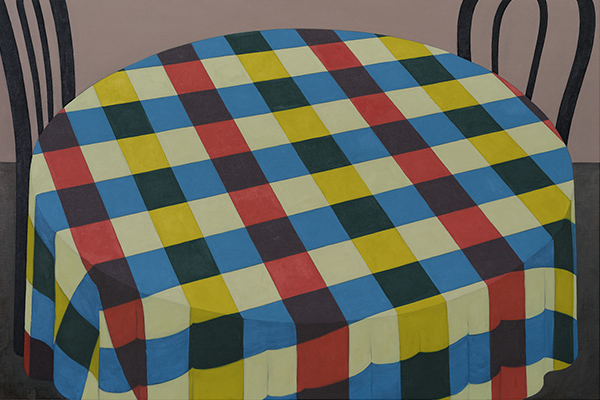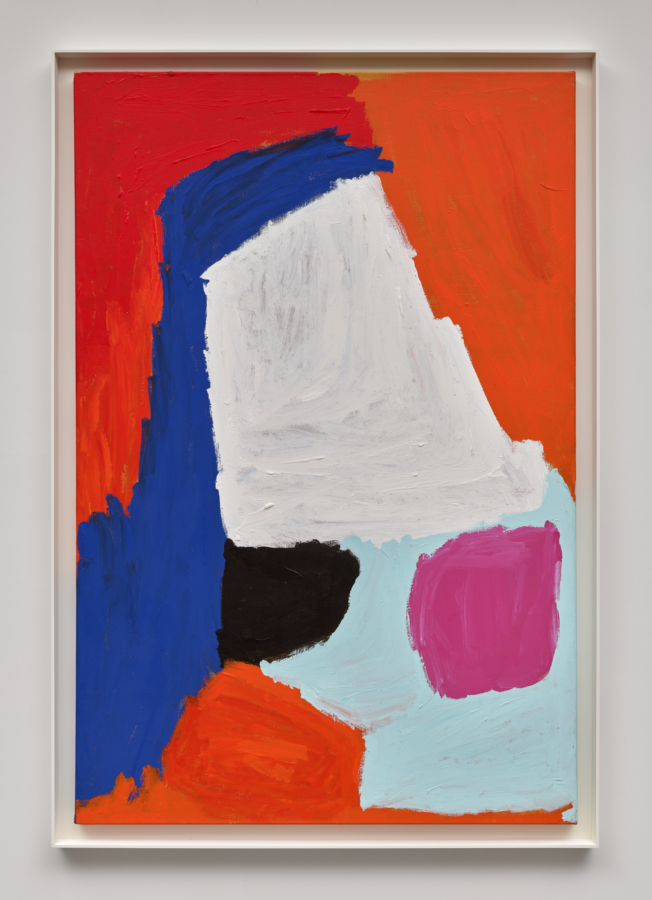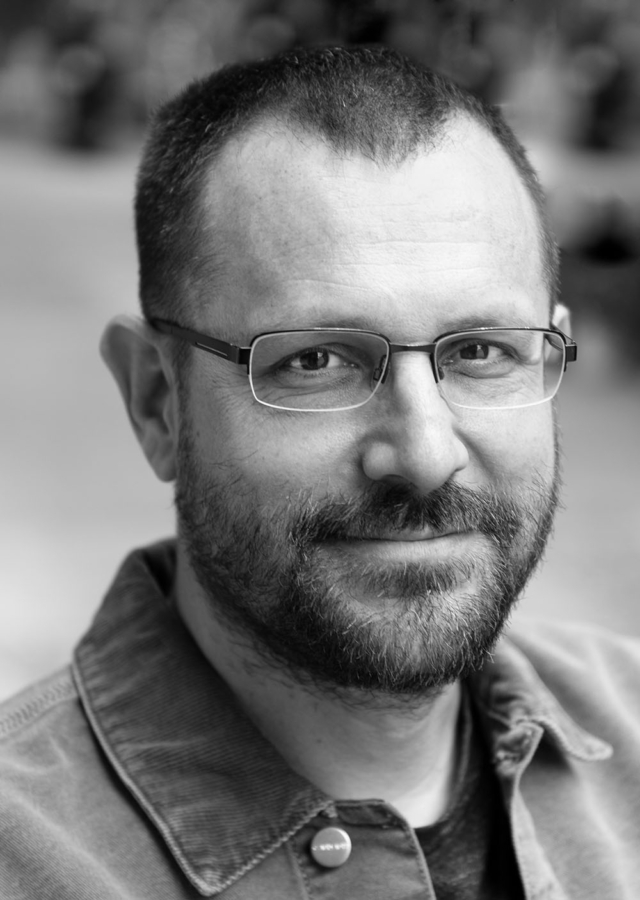February 14, 2000
Louise Fishman published by Cheim & Read, New York, 2000
Seeing them becomes thinking. —Leo Steinberg
Louise Fishman was born in 1939, and is part of the generation that includes Robert Mangold (b. 1937) and Brice Marden (b. 1938). While both Mangold and Marden were central figures in the ascension of Minimalism, which, historically speaking, eclipsed Abstract Expressionism, Fishman took a very different route than that of her male peers. In 1970, shortly after the beginning of both the gay liberation movement and feminism, she made the decision to engage with art-making practices that were identified with women. In effect, she stopped painting abstract grids and began making hybrid works—they were often neither quite sculpture nor painting—that required cutting, tearing, wrapping, sewing, and stitching. In doing so, Fishman, like a number of other women artists at that time, consciously embraced a territory that Eva Hesse (1936–1970) had brilliantly but only briefly explored.
The art that Fishman made during the first half of the 1970s conveys her commitment to, as well as her advocacy of, a history that was both untold and largely populated by women. It was a history on the margins of the history of power. Thus, instead of continuing to define modular units, she initiated processes that involved acts of repetition. Now, three decades later, it is this history, in all its personal and public manifestations, that she continues to bring to bear in her paintings; and it is her bold and forthright articulation of them within the realm of abstraction that distinguishes her from both an earlier generation and from her peers. In this regard, Fishman’s independence is exemplary of the women artists of her generation who wanted to find their own way in a medium that many critics had declared officially dead by the time they had arrived on the scene.
Bluntly put, Fishman and other women artists of her generation asked themselves: How do you become a painter when painting has been officially declared dead? In asking themselves this question, they are really asking a far larger one: How do you become a painter when you have always been placed in the position of coming after someoneor something else, as in, after Manet and Degas, after Picasso and Matisse, after Pollock and de Kooning, after Johns and Rauschenberg, after Warhol and Lichtenstein, after painting is pronounced dead, and history is declared over? Certainly, the implications of being a woman artist who asks these questions still resonate some three decades later.
Understanding the unique trajectory of Fishman’s career within this context, it is clear that one of the most salient issues her work raises is whether or not one should try and belong, or decide to become unequivocal and resist the temptation to assimilate. By equating artistic and personal freedom with unrelenting resistance, Fishman adamantly refuses to fit in.
One senses that Fishman, along with such peers as Dorothea Rockburne (b. 1932), Mary Heilmann (b. 1940), Elizabeth Murray (1940–2007), and Pat Steir (b. 1940), were possessed by a quiet fierceness, by an intense and determined flame. Looking back at the 1960s and ’70s, decades marked by the Vietnam War, race riots, and the rise of discourses such as feminism, is it any wonder that a significant number of women chose to work outside the boundaries of Minimalism, a territory which had quickly become largely occupied by men, but within the realm of abstract painting? That so many of them committed themselves to painting and have since achieved an original oeuvre is certainly a real cause for celebration.
Fishman’s response to Abstract Expressionism was not reductive. In contrast to her male Minimalist peers, she neither rejected gesture nor tried to extend the pure geometry associated with Barnett Newman and Ad Reinhardt. Instead, she melded geometry and gesture together to both extend and reconceive the roughness we associate with Abstract Expressionism. The difference is that the roughness one sees and literally can feel in Fishman’s paintings has little to do with Franz Kline and Willem de Kooning. Rather, she understood that, in their application of writerly calligraphic strokes, artists such as Bradley Walker Tomlin, Philip Guston, and Mark Tobey had defined a fertile if largely overlooked possibility. And in the case of Tomlin—and Guston, whom he had influenced—the source was the plus-minus paintings of Piet Mondrian, and a moment when geometry still came from the hand.
Here again, we ought to recognize within a larger historical context why Fishman might have been determined not only to keep the hand in painting, but also to refuse to take up the elegance and refinement one readily finds in the work of Tomlin, Guston, and Tobey. After all, what does it mean to withdraw the hand from painting, as, say, Andy Warhol did in the early 1960s, when the active presence of a woman’s hand in painting has seldom, if ever, been recognized? Just in her reinvention of gestural painting, not to mention the subjects it can be made to address, Fishman causes us to stop and rethink many of the presumptions we have made about the history of both Abstract Expressionism and the linear progress of abstract painting.
Fishman’s rejections have never been nihilistic. If anything, in both the way she paints and in the subjects she addresses, it is clear that the very opposite is true. At the outset of her career, Fishman realized that painting didn’t have to be monumental in scale, and that gesture didn’t have to be muscular and expansive. In fact, a painting, and the gestures within it, could be both intimate and rough, open and delicate. They could be blunt flicks of the brush rather than lines activating space. A gestural abstract painting could in fact be something altogether different than what was achieved by a previous generation.
Aware that history is messy, a contested field of told and untold narratives, Fishman understands painting to be a tradition that one continues by making it up as one goes along. Certainly since 1970 she has done just that. For her, rupture and renewal are two sides of the same coin. Thus, in addition to the roughness that is characteristic of many of her paintings, in the late 1980s, she was able to transform Reinhardt’s extinguished light into what Michael Brenson eloquently identified as “little more than an ember.” In recent years, that ember has grown into glinting bits and shards, into mineral rather than ashen light.
Whereas, in both his black paintings and in his proscriptive lists of what painting could and could no longer do, Reinhardt tried to be the last painter making the last painting in the first decade after the Holocaust. In the late ’80s, more than forty years after the war, Fishman enacted in paint visual prayers of Remembrance and Renewal, as she collectively titled her exhibition of the paintings she did after going to Auschwitz and Terezin. Finally, in terms of color, Fishman rejected the formal palette practiced by Newman, the urban environment evoked by Kline’s use of charred blacks and sooty whites, and the fleshy pinks and reds, lush greens, deep ocean blues, and hot yellows of de Kooning. Instead, she has developed a palette that evokes ashes and minerals, the earth dug into, turned over, and churned up until its deepest, most hidden and precious stones have been brought into the light.
This isn’t to suggest that Fishman is working in a visionary or transcendental vein, because she clearly isn’t. Her erosions don’t strike me as the result of grand or natural forces. Her sediments of color are hardly pure. Everywhere in Fishman’s paintings the passionate pressures of her hand are evident.
In her recent painting, most of which she finished this year, Fishman continues to extend herself in a number of very different directions, to push into what is for her new territory. As a body of work, the paintings seem more different than alike. The one similarity they do share is that they have lived many lives before Fishman has let them leave her studio. It is evident that she will work on a painting quite a lot, then sand or scrape it back down and then paint over it. Through this process of adding and subtracting and adding again, she is able to arrive at something quite unexpected. The surfaces are layered, dug into, torn open, and peeled back. One is reminded of ruined, open structures built upon the ruins of earlier structures.
Compositionally, some paintings consist largely of calligraphic marks, an element she first introduced into her work in 1996. During this time she has grown increasingly free in the way she lays down the paint. Consequently, the marks range from the angular to the sinuous, from being tangled together to being contiguous. In Pisser (2000), for example, the relatively blunt vertical and horizontal calligraphic smears seem to be floating like leaves on a watery, changing surface. In evoking men and malehood, might Fishman not be taking a certain mischievous delight in turning the tables on de Kooning and his representation of women? In Odd Mercy (2000), the narrow, reedlike vertical and horizontal calligraphic strokes float on a layered, seemingly receding surface. The dark tonalities convey a hushed moment, a place of whispers dissolving into silence. Finally, in Deep End (2000), the sinuous strokes are tangled together like brush.
Despite the intense differences in, and compelling particularities of, each of her paintings, Fishman continues to subvert all the analogiesand formal presumptions we associate with the gestural painters connected to Abstract Expressionism. The issue that is central to Fishman’s subversions is her redefining of the analogy—or is it by now a historical assumption?—which connects oil paint to flesh. When de Kooning proposed that oil paint had to exist as it was the only material that could evoke the flesh, he was thinking of women’s bodies as both idealized and terrifying presences. For him, women were both goddesses and monsters. They weren’t individuals so much as the outcome of a male projection.
As de Kooning defined the burden of painting, oil paint was the only medium capable of becoming flesh and thus able to make masculine eroticism palpable in every sense of the word. In his attempt to both locate and express his understanding of a woman’s body in paint, he tended to articulate a splayed figure in a shallow illusionistic space. Rejecting parody and ironic citation, characteristics we find in the work of Peter Saul, for example, or Robert Colescott, Fishman has done nothing less than transform the post-Cubist, figure–ground relationship conveyed by de Kooning’s supple strokes and hard slashes of thick, viscous color into a very different proposal. She merges figure and ground, so that the painting becomes both a body and a field.
Fishman replaces illusionistic space with a layered space, one that has been scraped, dug up, and partially covered over. If the body analogy holds in her paintings, and I think it does, it is because she has connected the body to the earth and ultimately to history and its repeated conflicts and conflagrations. To continue the body–paint analogy, instead of defining a figure in an abstract space, she excavates both figural elements and calligraphic traces from the paint plane. The elements and traces can be read as signs of a vanished human presence as well as the artist’s attempt to formulate her own elegiacal language.
If we approach Fishman’s excavations like an archaeologist, and begin isolating and defining the kinds of gestural strokes and calligraphic traces the artist makes, we will recognize that some are imbedded in a churned-up physical field, that some are partially covered over, and that still others seem to be resting right on the surface, hovering between physical presence and cast shadow. And within this group, it will be apparent that some of the strokes appear to be melting, while others feel like they could be physically lifted up from the surface.
The range of Fishman’s excavations conveys an intensity and urgency that is heartbreaking. It’s not like she is digging up the same painted field or figure or some version of them, over and over again. It’s more like she is trying to uncover each and every trace of a forgotten figure or calligraphic trace that lies under our feet. This sense of uncovering and memorializing is movingly conveyed by the painting In Paul’s Hands (2000), which Fishman did after she moved into the apartment of the deceased writer Paul Schmidt, the brilliant translator of Khlebnikov, Rimbaud, and Chekhov.
The interlocking, semi-transparent field of different-toned, washed-out, jade-green calligraphic bands can be read as separated parts being put back together, as a field of ideogrammatic strokes (or traces of writing), and as a puzzle in which the pieces will never be able to fit smoothly together. It is a painting of a world which has either been permanently torn apart or cannot be reassembled. At the same time, because some of the marks are dense, some are semi-transparent, some have edges that are dissolving into the layer below, and some seem scraped and in a state of erasure, In Paul’s Hands envisions a world in which change is continuous. It defines a place where some things are on the verge of becoming, while other things are in a state of dissolving and decay.
In the provocatively titled painting Kept Secrets (2000), the allover field of abraded strokes both partially covers and partially reveals what’s beneath. Flashes of glinting blue and bright red keep poking through the layers of reddish-brown or cinnabar. In Reckoning (2000), the greenish strokes are melting and dissolving into the greenish-white layer below, while in Out of Here (1999), the three increasingly larger, ascending accumulations of troweled, largely brown paint seem to be rising out of the ashen white layer below. If the painting is celebratory, it is a celebration imbued with pain.
The goal of Fishman’s excavations seems to be twofold: discovery and renewal. At a moment when technology threatens to change the human body into something quite different and perhaps even unrecognizable, at least to us, Fishman transports the history of that which has been covered over, hidden, and buried into the vertical or living world. The sentiment is clear: we will make of ourselves what we make of this earth. That this is not all that her paintings are about is equally evident.



